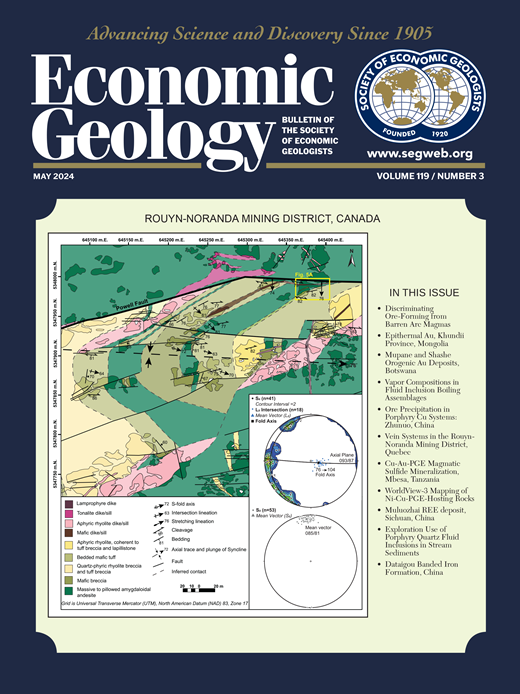Nature and Origin of a Massive Sulfide Occurrence in the Karrat Group: Evidence for Paleoproterozoic VMS Mineralization in Central West Greenland
IF 4.9
1区 地球科学
Q1 GEOCHEMISTRY & GEOPHYSICS
引用次数: 0
Abstract
Mafic volcanic rocks of the Kangilleq Formation of the Paleoproterozoic Karrat Group host volcanogenic massive sulfide (VMS) mineralization in the area of central Kangiusap Kuua, central West Greenland. The mafic volcanic rocks display evidence of subaqueous, effusive eruption and redeposition by mass debris flows generated along fault scarps on the sea floor. A zone of semiconformable quartz alteration and disconformable chlorite alteration within hydrothermal breccias and mafic tuff breccias near the top of the volcanic sequence is interpreted to reflect a synvolcanic hydrothermal system. Conformable, massive to semimassive, and discordant, stringer-style sulfide mineralization is hosted within the quartz- and chlorite-altered volcanic rocks. The massive to semimassive sulfide mineralization is ~10 m thick and crops out along strike for ~2,000 m. The stringer zone is ≤10 m thick with individual sulfide stringers ranging in width from 5 to 90 cm. All sulfide zones are dominated by coarse pyrrhotite and pyrite, with trace amounts of sphalerite and chalcopyrite. The pillow lavas are subalkaline with geochemical characteristics typical of modern transitional to tholeiitic mid-ocean ridge or back-arc basin basalt. Trace element and Nd isotope data suggest that these lavas erupted in an epicratonic, back-arc basin. Characteristics of the host rocks indicate a period of localized rifting, volcanism, and VMS formation during genesis of the Karrat Group, which is dominated by siliciclastic rocks.卡拉特群大规模硫化物矿床的性质和起源:格陵兰岛中西部古生代 VMS 矿化的证据
在西格陵兰岛中部的 Kangiusap Kuua 中部地区,古新生代卡拉特组 Kangilleq 地层的岩浆火山岩承载着火山成因块状硫化物矿化。岩浆状火山岩显示了水下喷发和沿海底断层疤痕产生的大量碎屑流重新沉积的迹象。在火山序列顶部附近的热液角砾岩和黑云母凝灰岩角砾岩中,有一个半变形石英蚀变和不变形绿泥石蚀变区,据解释,这反映了一个同步火山热液系统。石英和绿泥石蚀变的火山岩中蕴藏着顺应性、块状至半块状、不和谐的绞股蓝式硫化物矿化。块状至半块状硫化物矿化物厚约 10 米,沿走向延伸约 2,000 米。所有硫化物区都以粗黄铁矿和黄铁矿为主,还有微量的闪锌矿和黄铜矿。枕状熔岩呈亚碱性,具有典型的现代过渡至透辉石型洋中脊或弧后盆地玄武岩的地球化学特征。微量元素和钕同位素数据表明,这些熔岩是在后弧海盆中喷发的。母岩的特征表明,在以硅质碎屑岩为主的卡拉特组的形成过程中,曾发生过局部的断裂、火山活动和VMS形成。
本文章由计算机程序翻译,如有差异,请以英文原文为准。
求助全文
约1分钟内获得全文
求助全文
来源期刊

Economic Geology
地学-地球化学与地球物理
CiteScore
10.00
自引率
6.90%
发文量
120
审稿时长
6 months
期刊介绍:
The journal, now published semi-quarterly, was first published in 1905 by the Economic Geology Publishing Company (PUBCO), a not-for-profit company established for the purpose of publishing a periodical devoted to economic geology. On the founding of SEG in 1920, a cooperative arrangement between PUBCO and SEG made the journal the official organ of the Society, and PUBCO agreed to carry the Society''s name on the front cover under the heading "Bulletin of the Society of Economic Geologists". PUBCO and SEG continued to operate as cooperating but separate entities until 2001, when the Board of Directors of PUBCO and the Council of SEG, by unanimous consent, approved a formal agreement of merger. The former activities of the PUBCO Board of Directors are now carried out by a Publications Board, a new self-governing unit within SEG.
 求助内容:
求助内容: 应助结果提醒方式:
应助结果提醒方式:


